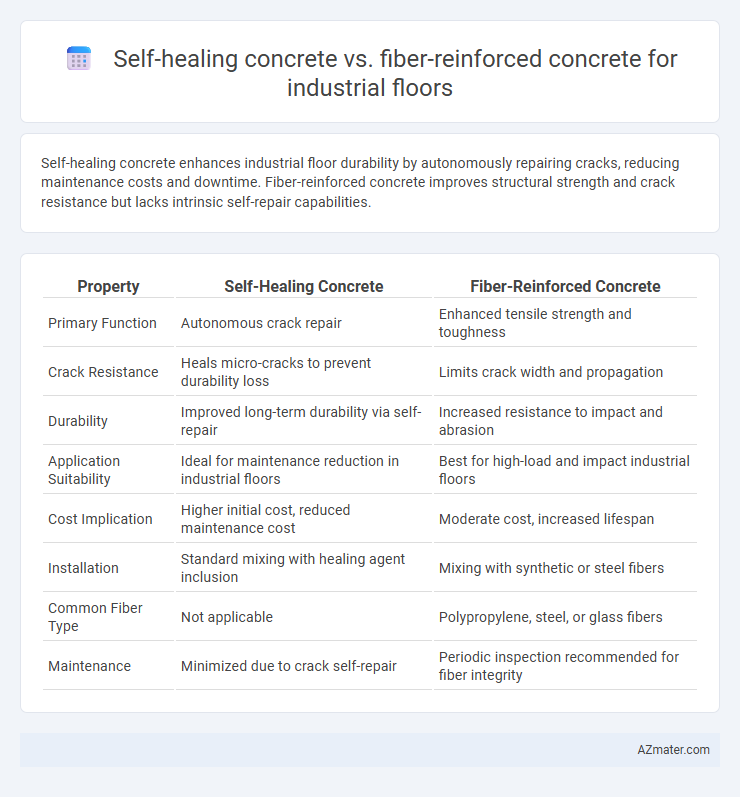Self-healing concrete enhances industrial floor durability by autonomously repairing cracks, reducing maintenance costs and downtime. Fiber-reinforced concrete improves structural strength and crack resistance but lacks intrinsic self-repair capabilities.
Table of Comparison
| Property | Self-Healing Concrete | Fiber-Reinforced Concrete |
|---|---|---|
| Primary Function | Autonomous crack repair | Enhanced tensile strength and toughness |
| Crack Resistance | Heals micro-cracks to prevent durability loss | Limits crack width and propagation |
| Durability | Improved long-term durability via self-repair | Increased resistance to impact and abrasion |
| Application Suitability | Ideal for maintenance reduction in industrial floors | Best for high-load and impact industrial floors |
| Cost Implication | Higher initial cost, reduced maintenance cost | Moderate cost, increased lifespan |
| Installation | Standard mixing with healing agent inclusion | Mixing with synthetic or steel fibers |
| Common Fiber Type | Not applicable | Polypropylene, steel, or glass fibers |
| Maintenance | Minimized due to crack self-repair | Periodic inspection recommended for fiber integrity |
Introduction to Innovative Concrete Solutions for Industrial Floors
Self-healing concrete integrates microcapsules or bacteria that autonomously repair cracks, enhancing durability and reducing maintenance costs for industrial floors subject to heavy loads and wear. Fiber-reinforced concrete incorporates synthetic or steel fibers to improve tensile strength and crack resistance, ensuring structural integrity in high-traffic industrial environments. Both innovative solutions address common challenges in industrial flooring but target different performance aspects, with self-healing focusing on longevity and fiber reinforcement emphasizing mechanical resilience.
What is Self-Healing Concrete?
Self-healing concrete is an innovative construction material designed to autonomously repair cracks through embedded healing agents, such as bacteria or polymers, extending the lifespan and durability of industrial floors. Unlike fiber-reinforced concrete, which relies on synthetic or natural fibers to improve structural integrity and crack resistance, self-healing concrete actively restores its microstructure without manual intervention. This technology reduces maintenance costs and enhances industrial floor performance by preventing water ingress and chemical damage that typically degrade concrete surfaces.
What is Fiber-Reinforced Concrete?
Fiber-reinforced concrete (FRC) incorporates various types of fibers--such as steel, synthetic, or glass--to improve its structural integrity and resistance to cracking, making it ideal for industrial floors. These fibers distribute stress more evenly across the concrete matrix, enhancing durability and reducing the likelihood of surface wear under heavy machinery and frequent loads. FRC is often compared with self-healing concrete, but its primary advantage lies in immediate reinforcement and crack resistance rather than autonomous crack repair.
Key Mechanisms: Self-Healing vs. Fiber Reinforcement
Self-healing concrete for industrial floors utilizes encapsulated healing agents or microbial activity to autonomously repair microcracks, enhancing durability and reducing maintenance costs. Fiber-reinforced concrete incorporates synthetic or steel fibers that distribute stress, control crack propagation, and improve tensile strength, thereby increasing resistance to wear and impact. While self-healing mechanisms target crack remediation after formation, fiber reinforcement provides immediate mechanical support to prevent crack development, making each technology suitable for different durability strategies in industrial flooring.
Durability and Crack Resistance Comparison
Self-healing concrete enhances durability by autonomously repairing micro-cracks through embedded healing agents, significantly extending industrial floor lifespan and reducing maintenance costs. Fiber-reinforced concrete improves crack resistance by distributing stress and controlling crack propagation, providing immediate toughness but lacking the intrinsic repair mechanism of self-healing systems. Industrial floors benefit from self-healing concrete's long-term crack mitigation, while fiber reinforcement delivers superior initial structural integrity under heavy industrial loads.
Performance Under Heavy Load and Traffic
Self-healing concrete enhances industrial floor durability by autonomously repairing microcracks, reducing maintenance needs and extending service life under heavy load and traffic conditions. Fiber-reinforced concrete improves load-bearing capacity and crack resistance through the distribution of synthetic or steel fibers, offering superior toughness and impact resistance critical for industrial floors. Combining self-healing agents with fiber reinforcement can optimize performance by addressing both crack initiation and propagation in high-stress environments.
Maintenance and Longevity: Which Lasts Longer?
Self-healing concrete enhances maintenance efficiency by autonomously repairing microcracks, significantly reducing the need for manual interventions and extending industrial floor durability. Fiber-reinforced concrete increases structural integrity and crack resistance but still demands routine maintenance to address larger fissures and wear. Studies indicate self-healing concrete can extend floor lifespan by up to 30%, outperforming fiber-reinforced variants in long-term durability under industrial stress conditions.
Cost Analysis: Self-Healing vs. Fiber-Reinforced Concrete
Self-healing concrete offers long-term cost savings by reducing maintenance and repair expenses due to its ability to autonomously seal cracks, despite a higher upfront price compared to traditional mixes. Fiber-reinforced concrete typically presents a moderate initial cost increase with improved durability and resistance to cracking but may incur more frequent maintenance over time compared to self-healing variants. Industrial floor projects benefit economically from self-healing concrete when lifecycle costs, including downtime and repair interventions, are prioritized over initial material investment.
Environmental Impact and Sustainability
Self-healing concrete significantly reduces maintenance frequency and extends the lifespan of industrial floors by autonomously repairing microcracks, thereby minimizing resource consumption and waste generation over time. Fiber-reinforced concrete enhances durability and crack resistance by distributing stress across fibers, which decreases the need for frequent repairs but involves higher initial use of synthetic or steel fibers with a notable environmental footprint. Choosing self-healing concrete promotes better sustainability through lower lifecycle emissions and reduced material replacement, while fiber-reinforced concrete offers immediate strength benefits but may contribute to environmental burdens depending on fiber type and sourcing.
Choosing the Right Concrete for Industrial Floors
Self-healing concrete enhances durability by autonomously repairing cracks through embedded bacteria or microcapsules, reducing maintenance costs and extending the lifespan of industrial floors. Fiber-reinforced concrete improves structural integrity and crack resistance by incorporating synthetic or steel fibers, offering superior load-bearing capacity and impact resistance for heavy-duty industrial environments. Selecting the right concrete depends on factors like expected load, exposure to chemicals, maintenance frequency, and cost considerations, where self-healing concrete suits applications prioritizing longevity and low upkeep, while fiber-reinforced concrete excels in high-strength, abrasion-resistant flooring.

Infographic: Self-healing concrete vs Fiber-reinforced concrete for Industrial floor
 azmater.com
azmater.com